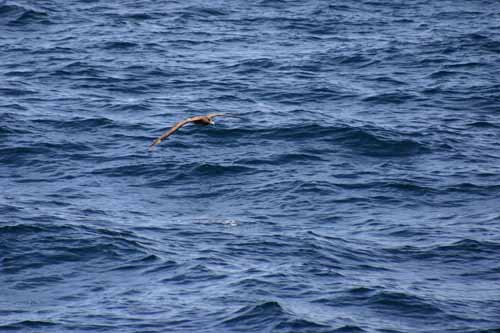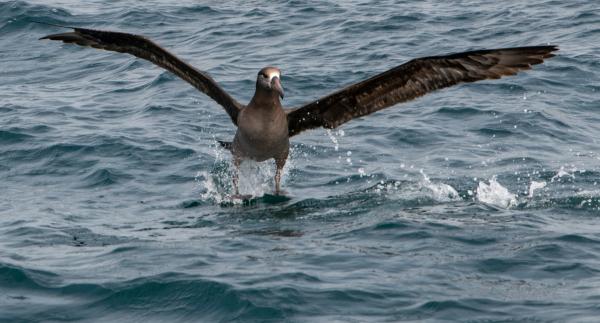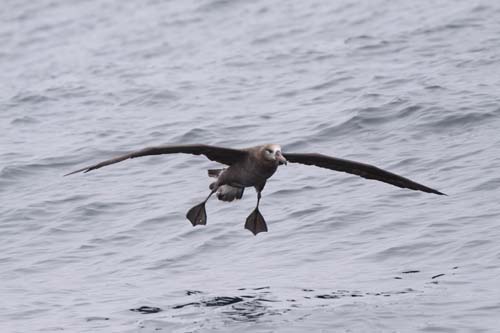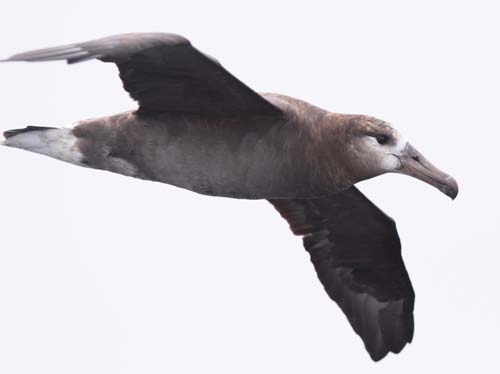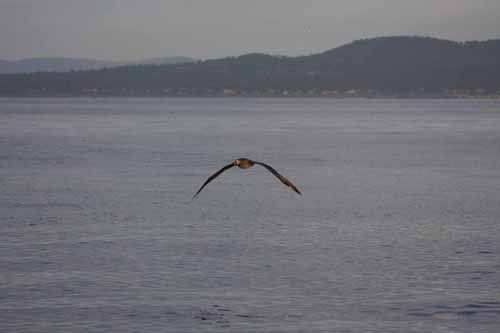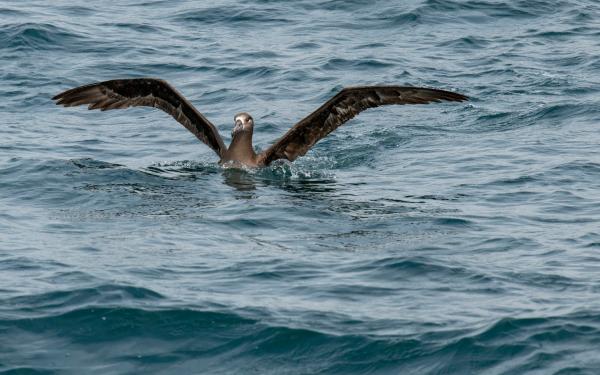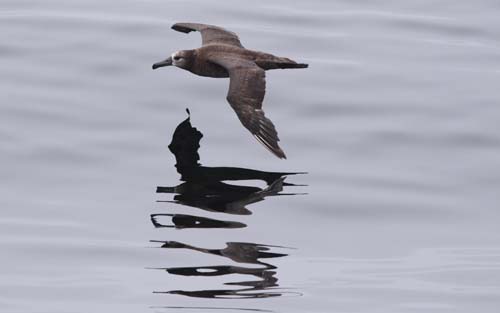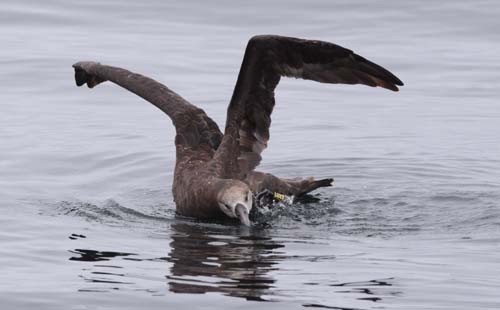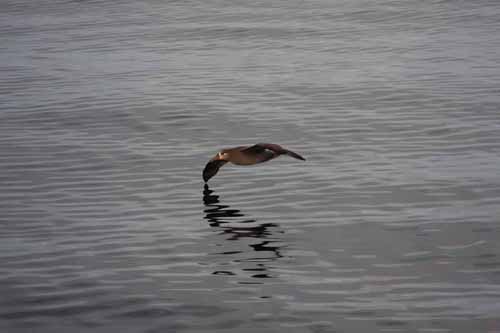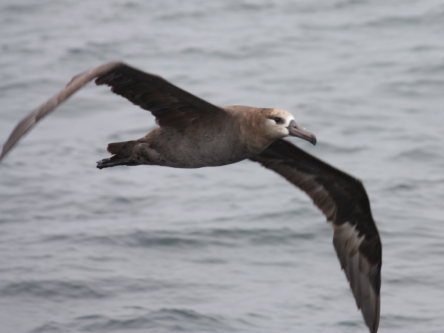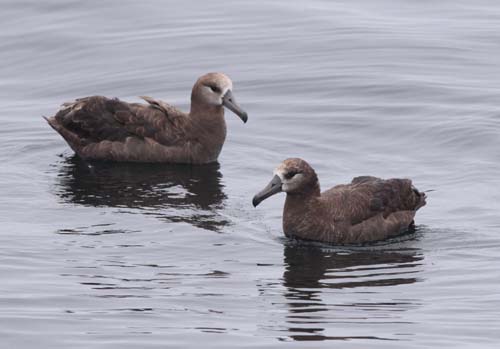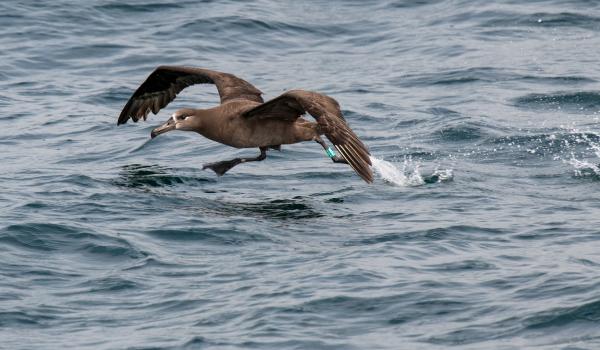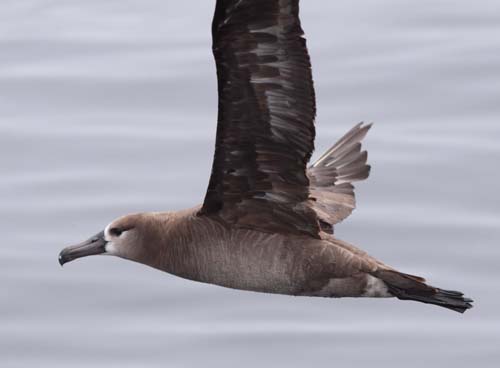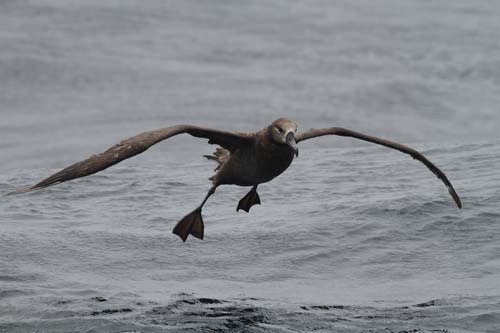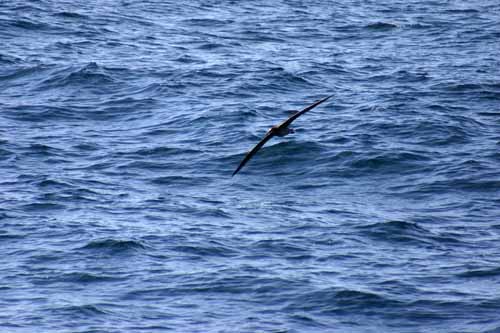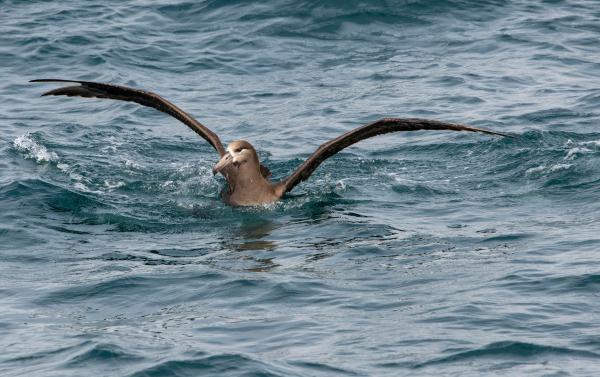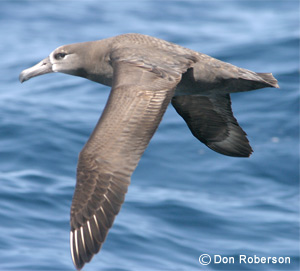
Black-footed Albatross
Phoebastria nigripes
Overview
Key Features:
Dark,almost black, bill and black webbed feet and legs. This is a very large bird, but smaller than the Short-tailed Albatross, with long wings, gray-black body, and white ring around face at base of bill. Can soar for long periods, never flapping wings but riding air currents.Similar Species:
Short-tailed Albatross (Phoebastria albatrus)Laysan Albatross (Phoebastria immutabilis)
Primary Common Name:
Black-footed AlbatrossSynonymous name(s):
Diomedea nigripesGeneral Grouping:
Seabirds and shorebirdsGeographic Range:
Southern Bering Sea, northern Pacific to southern Baja California
The Black-footed Albatross ranges from the Bering Sea and the Northern Pacific to southern Baja California, using primarily the Northwestern and Northeastern Pacific, while the Laysan Albatross tends to be found in the Central North Pacific. It may be seen in MBNMS waters all months of the year. However, February through August is when they are more likely to be seen. From shore the best viewing areas are Point Pinos in Pacific Grove and Point Joe and Cypress Point in Pebble Beach. They are usually well off shore and seen more often from ships.Habitats:
exposed sandy beaches, pelagic zoneNotes:
Forages at sea, often follows ships, and nests on sandy oceanic islands.Abundance:
Relative Abundance:
Fairly common offshore, particularly between February and July. Over 100 individuals have been seen on a single day in MBNMS waters, but that is rare. It is the most frequently sighted albatross off the west coast of North America.Species Description:
General:
Gray-black body and mantle. A white ring circles the base of the bill on mature birds. Undertail coverts are pale to white. Feet and legs are black and bill is dark (distinguishing it from Laysan and Short-tailed Albatrosses). The eyes are brown. Both genders have similar coloration. The males are heavier and have a larger bill. The sounds made vary from a nasal double-bray to loud single notes and growls. They are usually lower, louder and more nasal than a Laysan Albatross. Both Black-footed and Laysan Albatrosses are equipped with specialized "salt glands" above their eyes that process excess salt. The glands produce a salty solution that is excreted through the birds' nostrils and down grooves of their beaks, where it drips off.Distinctive Features:
Dark bill and black legs and feet. Albatrosses are distinguished from all other seabirds by their large size, long slender wings, large bills, and their soaring, steady flight with seemingly endless gliding. When sitting on the water they lose their graceful appearance and float like a giant gull. Albatrosses cannot take off in calm air but must run across the surface of the water, into the wind to become airborne. This is also true of the time they spend on land, needing to run across the sand into the wind, flapping madly to gain altitude.Size:
Length: 64-81 cm (26-32 inches); wingspan: 193-216 cm (6-7 feet); life span 12-50 yrs. Adults weigh about 3.2 kg to 4.3 kg(7-9 pounds). Males are about 10% heavier than females.The Black-footed Albatross is slightly heavier than the Laysan Albatross and has longer wings and a stockier look in flight.Natural History:
General:
The Black-footed Albatross comes to land, 96% of them to the northwestern Hawaiian archipelago, for breeding purposes only. The rest of its life is spent on the open ocean. It drinks seawater and excretes excess salt through glands above the eye. It has a keen sense of smell which helps in locating food in large expanses of ocean. The breeding adults (and younger 3 to 5 year olds) arrive at their nesting sites by the end of October, and incubate and brood their single chick on low, flat islets and atolls from November until February. The parents continue to feed their chicks from March until June. They spend the non-breeding season in the North Pacific Ocean (30-60 degrees northern latitude). They mate for life and can live as long as 40 years. The longevity record for the black-footed albatross is 41 years (USGS 2007). A group of albatrosses are known collectively as a flight, a rookery, or weight of albatrosses.Predator(s):
The only known native predator of both the Black-footed and Laysan Albatrosses in Hawaii is the tiger shark (Galeocerdo cuvieri). The shark attacks the fledglings when they are leaving land for the first time. On land, non-native dogs, cats, pigs, mongooses, rabbits, and rats affect the size and productivity at breeding colonies and may restrict the reoccupation of some historical nesting sites.Prey:
Their broad diet is dominated by flying fish and their eggs and some squid and crustaceans. They seize from the surface flying fish (Family Exocoetidae), both egg masses and adults, and secondarily squid (Order Teuthoidea). They will also consume crustaceans, other invertebrates and carrion. Prey species include the following fishes: pomfrets Brama japonica, Pacific saury Cololabis saira, grenadier Coryphaenoides sp., chubby flashlight fish Electrona risso, snake mackerel Gempylus serpens, brokenline lanternfish Lampanyctus jordani, blue shark Prionace glauca, shining tubeshoulder Sagamichthys abei, unidentified flying fish (Exocoetidae), unidentified cod-like fishes (Moridae), and unidentified lanternfishes (Myctophidae). They also are attracted to garbage.Feeding Behavior:
Carnivore, ScavengerNotes:
They are diurnal feeders. Unlike the Laysan Albatross, they do not have retinas with high levels of rhodopsin for night vision. Thus competition for food between the Laysan and the Black-footed Albatross is minimal. The Black-footed will take mostly flying fish eggs and adults, while the Laysan will take more squid which float to the surface at night. The Black-footed, during daylight hours, are surface feeders and may make shallow surface dives, though they do not usually submerge completely. They scavenge on floating garbage and colorful plastic floating in the sea. Because of this behavior, and for their habit of taking kitchen scraps and offal from ships, they have been described as floating pigs.Seasonal Behavior
July - September
Migration:
The Black-footed Albatross spends July, August and September in the Northern Pacific Ocean, ranging from Alaska to California and Japan. It has no set migration pattern but seeks squid and fling fish and lesser crustaceans. They also follow fishing vessels eating discarded scraps.October - November
Migration:
Three year old Black-footed Albatrosses return to their breeding site. Low, flat islands in the open sea is the preferred breeding/nesting area and they always return to the area where they hatched.Reproduction:
Adults of five years of age or more seek mates and begin an elaborate courtship ritual. Most have their first nest at around 7 years of age. Some Black-footed Albatrosses are 13 or 14 years old when they breed for the first time (Kendall et al. 2005). The nonbreeding albatrosses will observe and begin to practice the courtship moves, which include bill snapping, bowing, pointing the bill skyward, neck thrusting, preening, stepping in a dance-like manner and groaning. Both male and female participate and mirror each others movements. This unique method of bonding lasts up to two months. During this time the nest site is selected and scraped and groomed by both sexes. Black-footed Albatrosses prefer more open beaches and less vegetated sites compared to Laysans. This preference for more open areas coincidentally prevents their chicks from ingesting lead-based paint chips found near abandoned military buidings, where the Laysans often nest, raising chicks that are compromised by lead poisoning. Previously bonded pairs may lay one egg as early as late November. They do not always lay an egg every year, but may take one to two years off from the rigors of raising a chick.Feeding:
During this early part of the breeding season the adults return to sea to feed whenever they please.November - January
Reproduction:
The female Black-footed Albatross lays one white egg with brown speckling at the larger end. The egg is about 3.5 inches long. The female will stay with the newly laid egg for about 48 hours until the male takes over. He usually sits for the next 18 to 21 days until the female returns from feeding. They will continue to swtich sitting every 12 to 18 days until the egg hatches in 60 to 65 days. The egg is incubated for approximately 65 days. The male incubates more than the female, to allow the female foraging time to recoup nutritionally after the stress of egg-laying.Feeding:
Parents take turns going to sea to feed. The average shift time that each parent spends incubating is 18 days. Mates can wait on the nest up to 38 days, going without food or water, before they are relieved by their mate.January - March
Reproduction:
Chicks hatch from mid-January through mid-February. (Late season chicks have a higher mortality.) Upon hatching the chick is whitish-gray and downy and helpless. Its eyes are open. The chick is never left alone for the first 3 weeks and it is fed at least every 2 to 3 days. As the chick grows larger its demands for nourishment increase and the parents are gone longer periods searching for prey. The chick does not move from its nest site, even if it is raining and shelter is nearby. The primary cause of nest failure is desertion by a parent, which could be caused by a variety of factors including food shortages, the death of a member of the pair, or inexperience of the breeders. Flooding, strong storms, egg loss due to eggshell thinning, predation by introduced mammals, and oceanographic anomalies that result in food shortages, are also factors (Fisher 1971b, 1975a, Woodward 1972, Arata et al. in prep., USFWS unpubl. data).Feeding:
The chick is fed by regurgitation, first on stomach oil. Then parents go to sea looking for fish and small crustaceans. When the returning parent arrives at the nest the chick pecks at the lower beak until the parent opens its bill. The chick sticks its bill but not its head inside the parent's bill stimulating the stomach contents to be brought up. The rich flying fish eggs and squid, plus the parent's stomach oil, is filled with fatty acids and nutrients that can sustain the chick for days, while parents are at sea foraging. It is fed at least every 2 to 3 days when small. As the chick grows larger its demands for nourishment increase and the parents are gone longer periods searching for prey. Often, instead of fishes, squid and crustaceans, the parents have been attracted to colorful plastics floating in the ocean, which is regurgitated for the chick. Many chicks, full of plastic but no real food, die of starvation. Parents routinely fly over 2,300 miles from the Hawaiian Islands to the coast of California in search of food for their chick.April - May
Reproduction:
By mid-May the chick weighs about 3.2 kg (7 pounds), which is about 25 percent more than the average adult male, although during the following few weeks they lose this weight, grow adult feathers and start exercising their wings prior to leaving the nest.Feeding:
During these months the parents continue to feed their chick, leaving it for longer periods of time while they are at sea foraging. The parents may be flying 2000 miles or more round trip to get adequate food. They may be gone 10 to 14 days, staggering their feeding of the chick so that the chick is being fed about every 6 to 8 days. The chick begins to flap its wings vigorously, which develops musculature for flight.June - July
Migration:
Fledging occurs 4-5 months after hatching when parents leave the breeding grounds, abandoning their chick. The parents separate and return to sea to feed. The chick remains at the nest site, relying on fat reserves while completing their full juvenile plumage. The chick exercises and starts trying to fly. Eventually they are successful, usually getting the best conditions for takeoff at the beach. And so begins their 3 to 5 year sojourn at sea.Feeding:
Once the parents have returned to sea the chicks remain at the nest site waiting for a parent. During this time they complete their juvenile plumage and practice take-offs. Hunger eventually drives the full grown chick to leave the nest area and attempt flight. It will spend the next three to five years at sea feeding and maturing. Although a three year old may return to its natal site it does not mate and nest until at least the age of five, with 7 being the more likely age for a first mating.Issues
Monterey Bay National Marine Sanctuary:
The Black-footed Albatross is taken incidentally by long-line fishing and thus is considered endangered. It is estimated that 4,000 are taken every year, based on a 1990 estimate. Other estimates put the number at 8,000. Ingestion of oil and floating plastics is also a problem. In the past, around the late 1890's, they were also persecuted by feather hunters.Listing Status:
IUCN Species Redlist CITES page U.S. FWS Threatened and Endangered Species System (TESS)Monitoring Trends:
The Black-footed Albatross has been identified by the Internaltional Union for the Conservation of Nature (IUCN) as a focal species of management concern because of a projected 60% decline of the existing population over the next three generations (56 years). Accidental by-catch in long-line fisheries and illegal drift net operations pose a substantial threat. Other threats include ingestion of plastic debris and pesticides from scavenged food, oil pollution, introduced predators in nesting grounds and collision with man-made structures, including airplanes. Another threat includes nesting habitat loss and degradation due to invasive plant species. The loss of nesting habitat due to sea level rise is a potential future threat that, coupled with the paucity of secure nesting habitat on high islands, could have serious consequences, particularly in the core breeding range in the Northwestern Hawaiian Islands. When combined, some of these threats may have synergistic or cumulative effects as well. Globally, the black-footed albatross is listed by the IUCN as Endangered and the Laysan albatross is listed as Vulnerable (BirdLife International 2007). Both species are listed as Threatened in Mexico (6 March 2002 www.ine.gob.mx/ueajei/norma59.html) and in Canada, the black-footed albatross is a Species of Special Concern (COSEWIC 2007). The U.S. Fish and Wildlife Service (USFWS) is currently reviewing a petition to list the black-footed albatross under the Endangered Species Act (Earth Justice 2004)and both black-footed albatross and Laysan albatross are designated Birds of Conservation Concern (USFWS 2002). The Black-footed Albatross is designated as Threatened by the State of Hawaii.References
- Ehrlich, P., D.S. Dobkin, and D. Wheye. 1988. The Birders Handbook: A Field Guide to the Natural History of North American Birds. Simon & Schuster Inc., New York. 785 p.
- Midway Atoll National Wildlife Refuge,U.S. Fish & Wildlife Service, Department of the Interior, 2008. Birds of Midway Atoll, Black-footed Albatross. http://www.fws.gov/midway/bfal.html
- National Biological Information Infrastructure. http://focalbirds.nbii.gov Accessed October 30, 2008.
- OBIS-SEAMAP, seamap.env.duke.edu/ Accessed October 30, 2008.
- Roberson, D. 2002. Monterey Birds 2nd edition. Monterey Peninsula Audubon Society, Carmel, CA. 536 p.
- Sentman, W., personal communication, http://web.mac.com/naturefinder or http://naturefinder.blogspot.com/
- Sibley, D.A. 2000. The Sibley Guide to Bird. Alfred A. Knopf, Inc. 545 p.
- Whitlow, G. C. 2008. All About Birds: Black-footed Albatross. http://bna.birds.cornell.edu/bna/species/065/articles/introduction
- WWW
Articles on Hawaiian Birds and Birdwatching and Other Pacific Wildlife, Hawai'i's Albatrosses –The Black-footed Albatross.
http://www.birdinghawaii.co.uk/XBFAlbatross2.htm
Accessed 12/30/2008 for Black-footed Albatross - WWW
WhatBird.com. Field Guide to Birds of North America.
http://www.whatbird.com
Accessed 12/30/2008 for Black-footed Albatross
Accessed 01/30/2009 for Pelagic Cormorant
Accessed 02/28/2009 for Marbled Godwit
Accessed 04/14/2009 for Willet
Accessed 04/13/2009 for Heermann's Gull
Accessed 09/10/2009 for Eared Grebe
Accessed 06/20/2010 for Black Turnstone
Accessed 12/15/2009 for Black-crowned Night Heron
Accessed 10/13/2009 for Horned Grebe
Accessed 10/10/2010 for Pacific Loon
Accessed 10/30/2010 for Surf Scoter
Accessed 02/01/2011 for American Coot
Accessed 02/20/2011 for Western Sandpiper
Accessed 03/04/2011 for Least Sandpiper.
Related Information
Project Database
Photo Library
Click on an image below to view a larger version in the SIMoN Photo Library. You will also be able to view important information on each photo such as photographer, date, caption and more
